Rife with symbolic subject matter, Julie Curtiss’ exhibition Maid in Feathers is a personal meditation on early motherhood and psychological transformation. In this new body of work, Curtiss explores the shadow-side of quotidian scenes in acrylic and oil paintings, graphic gouache works on paper and lacquered sculptures. A hybrid bird-figure appears throughout as a proxy for the self, a means by which the artist negotiates the existential drama of self-realisation that accompanies birth and motherhood. At times, using the bird-figure to also conjure surreal scenes of servitude, Curtiss also explores the sexual politics underlying domestic and reproductive labour, animating it with comic levity.
In the artist’s own words, these works are ‘all about light and darkness, and difficulty’. The painting Cradles (2025) is a diptych; one of its panels shows two mothers in flowing ivory dresses tending to black prams, while in its mirror, their places are usurped by two pelicans with curved, coal-black beaks. A gateway into Curtiss’ wider body of work, Cradles stages an illusory metamorphosis: the maternal body becomes a chimeric creature and an everyday scene unravels onto a deeper psychic register, one of renaissance and becoming. Elsewhere, the monochromatic work on paper, Bassinet (2024), depicts the hood of a cot rippling gently in the breeze; demarcating another unseen space, the hood cloaks the child who sleeps on, out of sight. Here, themes of absence and transformation are foregrounded by the artist’s interest in psychoanalysis, particularly Donald Winnicott’s concept of transitional space: where inner world and external reality meet, and in which early psychic life unfolds.
The pelican, a bird rich with symbolic value, occupies a central place in many of the artist’s new works. In Christian iconography, the bird is linked to motherhood, self-sacrifice and resurrection. In alchemical texts hailing from the medieval period, the pelican functions as a symbol of transformation and spiritual nourishment. In psychoanalytic circles, too, the bird is named, notably in Carl Jung’s exploration of internal and external forces caught up in a continuous, ‘circular distillation, named the Pelican’. Gazing out into darkness, the pelican in Nocturnal Visitor (2025) recalls Jung’s ‘night sea journey’; dreamlike in quality, the work represents an immersion into the unconscious, perhaps one that the sleep deprivation of early motherhood invokes. Furthering existing associations of the pelican, Curtiss combines the bird’s likeness with that of the shoebill to create a ‘mischievous or demonic figure’. Simultaneously maternal and monstrous, the bird-hybrid’s occupation of the artist’s family home unsettles and perturbs.
Oeuf à la Coque (2025), meanwhile, presents us with a vision of staid domesticity in the form of a breakfast egg, that is then turned disquietingly erotic by the presence of a manicured hand. The feminisation of domestic roles extends to works such as Spring Cleaning and Woman with a Whisk (both 2025), the latter in which a woman can be seen whisking a bowl of eggs, her maternity bra falling at one side to reveal her left breast. Here, Curtiss reflects on the sexual politics of housework, compounding the notions of care, service and erotism so often bound up with an ideal of femininity. This ideal most forcefully comes to bear in Origine (2024) – Curtiss’ reinterpretation of Gustave Courbet’s 1866 L’Origine du monde – a confrontationally close crop of a woman’s exposed genitalia and thighs. Referring at once to a painting she created in 2016 titled D’après l’origine du monde, this new work on paper behaves equally as the artist’s record of bodily change.
Throughout the exhibition, imagery of eggs recurs as a sign of gestation and life-potential. In Cracked (2025), however, this symbolisation is laden with suggestions of psychical fragility, as fissures in the eggshell branch out from a site of impact by a brightly polished spoon. Echo (2025) takes this image of psychical fragility to its logical conclusion; in this eerie work on canvas, a female figure has been split into three, as though seen through broken and bleary vision. Multiple figures are again depicted in Defragmentation (2024), where three faceless figures can be seen to overlap, whilst in Self (2024), a mirror emptied of its reflection takes the place of any possible self-portrait. Pervaded by a sense of contradiction and tension, these new works of Curtiss’ explore the undertow of motherhood through intergenerational haunting and the critical limit of the stable self.
This destabilisation of self extends to the objects that surround it, which Curtiss casts as protagonists in a great upturning of reality. Pacifier, Substitute and Fountain (all 2024) all feature oversized infant paraphernalia that loom large within the compositional frame. Suffused with a childlike enchantment, the objects and their disproportion impart a sense of play, play being another idea crucial to Winnicott’s theories on infant development. The exaggerated scale evokes a child’s early engagement with the external world through touch and sensation – or play, in Winnicott’s terms – with which the infant sets out on their ‘journey of progress towards experiencing’. A series of sculptural works constructed from dried gourds continue this line of inquiry. Chosen for their rounded shapes, and the associated symbolism of fertility, the gourds take on the playful forms of a Pacifier and Lollipop (both 2025). Inspired by the geographical context of the exhibition, these sculptures are coated in natural lacquer resin, using a technique closely related to traditional Asian methods, which renders the sculptures with a seductive, glossy surface. The lacquer forms an impenetrable finish, transposing the organic forms into lustrous, hallucinatory objects, emblematic of Curtiss’ ongoing engagement with surrealist devices in which the mundane is promoted to the absurd, as in a dream.
Through symbolism, introspection and depictions of the uncanny, Curtiss plumbs the psychological depths of the maternal self. The artist’s sculptures and works on paper mobilise objects to produce scenes of foreboding and phantasy, while otherworldly oil paintings are lifted by brief moments of colour. With this exhibition, she interrogates a multitude of thresholds: that of the external world and internal conflict, past selves and future projections, play and eroticism – expressing a Jungian desire ‘to cross over from being to becoming’. Created in a period of early motherhood, Curtiss makes material internal contradictions and transmogrification of identity, looking out upon an ‘introspective journey ahead’.













